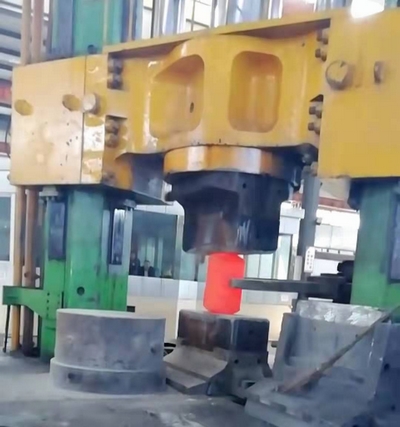Free forging is mainly used for the initial processing of ingots, i.e. the semi-finished bar with round, square or rectangular cross sections. When free forging is more economical than die forging in single or small batch production, it is usually used to manufacture large-size blanks.

From ingot to finished bar, the forging process is usually divided into three stages.
- Blanking
Its initial forging (billet) temperature is 150-250 C above the beta transition point, at which time, the plasticity of casting structure is the best. At the beginning, the ingot should be deformed by lightly and rapidly striking until the primary coarse grain structure is broken. The degree of deformation must be kept in the range of 20%-30%. The ingot is forged into the required cross section and then cut into a blank of fixed size.
The plasticity increases after the casting structure is broken. Aggregation recrystallization is aggravated with the increase of temperature, holding time and grain refinement. In order to prevent agglomeration recrystallization, forging temperature must be gradually reduced with grain refinement, and heating and holding time should be strictly controlled.
- Multidirectional repeated upsetting
It starts forging at 80-120 above the temperature of beta transition point, alternately upsetting and drawing 2-3 times, and alternately changing the axis and edge. In this way, a very uniform recrystallized fine grain structure with deformation characteristics in the beta region can be obtained in the whole section of the blank. If the blank is rolled on a rolling mill, such multi-direction upsetting is not necessary.
- Second multiple upsetting
It is the same as the first multi-directional upsetting, but the initial forging temperature depends on whether the semi-finished product is the blank of the next process or the product delivered. If the blank is used for the next process, the initial forging temperature can be 30-50 C higher than the beta transition temperature; if the product is delivered, the initial forging temperature is 20-40 C below the beta transition temperature.
Because of the low thermal conductivity of titanium, when upsetting or drawing blanks on free forging equipment, X-shaped shear bands are often formed on the vertical or cross sections if the preheating temperature of tools is too low, the strike speed of equipment is low and the deformation degree is large. This is especially true for non-isothermal upsetting on hydraulic press. This is because the tool temperature is low and the contact between the billet and the tool causes the surface cooling of the metal billet. In the process of deformation, the deformation heat generated by the metal can not conduct to the surrounding heat, and a large temperature gradient is formed from the surface to the center. As a result, the metal forms a strong flow strain band. The larger the deformation degree is, the more obvious the shear band is. Finally, cracks are formed under the action of tensile stress with opposite symbols. Therefore, when forging titanium alloy freely, the strike speed should be faster, the contact time between the blank and the tool should be shortened as far as possible, and the tool should be preheated to a higher temperature as possible. At the same time, the deformation degree in one stroke should be properly controlled.
When forging, the edges and corners are cooled fastest. Therefore, it is necessary to turn the blank several times during drawing and adjust the hammering force so as to avoid the sharp angle. In hammer forging, the initial stage should be lightly beaten, and the degree of deformation should not exceed 5%-8%. Then the amount of deformation can be gradually increased.
